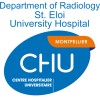
Study by Magnetic Resonance Imaging in the Progressive Forms of Multiple Sclerosis
Progressive Multiple SclerosisMultiple Sclerosis1 moreThe goal of this study is to show pattern differences of vasoreactivity and connectivity between Progressive Multiple Sclerosis and Relapsing Remitting Multiple Sclerosis, by the use of methods of advanced brain MRIs and the Diffusion Tensor Imaging , and correlate these differences with Clinical disability and cognitive disorder results.

Analyze the Myelin-TRAP as Diagnostic Tool in Multiple Sclerosis
Multiple SclerosisThe objective of this project is to characterize the response TRAP positive patients with Multiple Sclerosis (MS) and to evaluate the sensitivity and specificity of the method in order to develop a second time as a diagnostic tool in this disease. We plan to analyze the response TRAP over a hundred patients with various clinical stages SEP (relapsing, progressive forms) and compared to healthy controls,

Randomized Study Designed to Look at Disease Progression Using 2 Currently FDA Approved Drugs for...
Relapsing Remitting Multiple SclerosisRandomized study designed to look at the difference in relapse rates between patients remaining on their current interferon medication and those switched to Copaxone®

"Evaluation of Usability and Safety of the Self-balancing Walking System Atalante in Patients With...
Multiple SclerosisAtaxia1 moreMultiple sclerosis (MS) is the most prevalent chronic inflammatory disease of the central nervous system (CNS), affecting more than 2 million people worldwide,1 it is a degenerative disease that selectively affects the central nervous system and represents the main cause of non-traumatic disability in young adults. Gait and balance disturbances in MS are common even in the early stages of the disease. Half of the patients report some alteration in the quality of walking within the first month after diagnosis, reaching 90% after 10 years of evolution. 4 5 In addition, it is the symptom to which patients give the most importance 6 and the one that most conditions their activity and participation. 7 The causes of gait disturbance are multifactorial and are influenced by different aspects such as muscle strength, balance, coordination, proprioception, vision, spasticity, fatigue and even cognitive aspects4. There are multiple interventions, including aerobic, resistance training, yoga, and combined exercise, that have shown significant improvements in walking endurance, regardless of outcome measures (six-minute walking test (6MWT), two-minute walking test 2MWT). 8 In recent years, evidence has been growing around rehabilitation with robotic equipment in people with multiple sclerosis (PwMS), in their study Ye et al. concluded that robotic locomotor training has limited impact on motor functions in multiple sclerosis, but improves fatigue and spasticity, is safe and well-tolerated for PwMS, and less demanding for physical therapists.10 Bowman et al. concluded that robot-assisted gait therapy (RAGT) improves balance and gait outcomes in a clinically significant way in PwMS, RAGT appears more effective compared to non-specific rehabilitation, while showing similar effects compared to non-specific rehabilitation. specific balance and gait training in studies with level 2 evidence. RAGT has several advantages in terms of patient motor assistance, training intensity, safety and the possibility of combining other therapeutic approaches and should be promoted for PwMS with disability in a multimodal rehabilitation setting as an opportunity to maximize recovery.11 In this setting, more larger-scale and better-designed studies with longer training duration and more studies evaluating satisfaction, usability, and effectiveness are needed. of RAGT.

Effects of Physical Therapy and Dalfampridine on Functional Mobility in Non Ambulatory Persons With...
Multiple SclerosisThe goal of this interventional double blind, randomized placebo controlled trial was to assess the change in functional mobility, quality of life and cognition for subjects who receive physical therapy and take dalfampridine vs those who receive physical therapy and take a placebo in non ambulatory persons with multiple sclerosis. The main question[s] it aims to answer are: Does the addition of dalfampridine to Physical Therapy improve functional outcomes compared to Physical Therapy alone Does Physical Therapy improve functional outcomes in patients who are non ambulatory

Effect of Active-Passive Trainer Cycling on Multiple Sclerosis
Multiple SclerosisThis randomised controlled trial aims to explore the effectiveness of a four week programme of exercise using lower limb Active Passive trainer (APT) (MOTOmed trainer) in terms of spasticity in people with moderate to severe Multiple Sclerosis.

ATOMIC (Active Teens With MultIple sClerosis) Teens: A Feasibility Study
Pediatric Multiple SclerosisTaking part in recommended levels of physical activity in youth with MS may have an important and positive impact on disease symptoms, long-term disability and health outcomes. Unfortunately, youth with MS are highly inactive. In order to address this issue, the investigators have developed an MS-specific mobile application for teens called Active Teens with Multiple Sclerosis (ATOMIC). In this research the investigators will evaluate the feasibility of using the ATOMIC program in youth with MS. The results of this pilot study will provide the data necessary to ensure the ATOMIC program aligns with the needs of youth with MS.

Physiotherapist-guided Home Exercise in Moderate to Severe MS
Multiple SclerosisPhysical activity is a crucial component to wellness and is associated with multiple health benefits. Persons with MS may find it challenging to participate in regular physical activity or exercise, which is activity done to improve health and/or fitness. This research will test an innovative web-based intervention to help persons with moderate-to-severe disability manage their condition through a maintenance exercise program with specialized physiotherapist guidance and support. The researchers will examine adherence to the web-based physiotherapy program compared to standard physiotherapy care. Forty-five people with MS will be randomly assigned to the web group or standard care group at a rate of 2:1. Participants in the web group will receive supported and individualized web-based physiotherapy. Participants in the standard care group will receive a written exercise program. Regular participation (adherence) in the exercise programs will be evaluated in both groups over six months. The research will also examine participant satisfaction with the programs, safety, MS symptoms, and physical function. A web-based approach may be widely accessible to persons with MS in their own homes and could support long-term participation in physical activity important to wellness.

The Effects of Exercise in Patients With Systemic Sclerosis
Systemic SclerosisRaynaud's Phenomenon1 moreSystemic sclerosis (SSc) is a multisystem connective tissue disease characterised by vascular abnormalities and fibrosis, including those of the skin and can be categorised as either Limited cutaneous scleroderma or Diffuse cutaneous scleroderma. It is estimated that more than 90% of patients with SSc experience Raynaud's phenomenon (RP) at regular intervals during the course of their disease. Approximately 50% of patients with SSc develop severe digital ischaemia and/or ulceration which seems to be painful, difficult to heal, susceptible to infections and heavily influences quality of life and increases SSc-related disability. Medical treatment is commonly used as an effective first line approach in the NHS policy when uncontrolled RP attacks emerge. However, considering the short-term side effects (oedema, headaches, heart palpitations, dizziness and constipation) but also the long-term side effects of nifedipine (heart dysfunction and increased cardiovascular risk) as well as the financial cost of this approach, alternative approaches with less side effects and less cost implications are warranted. An alternative approach would be to implement a programme of therapeutic exercise that would be suitable for this patient group. To the investigators knowledge the efficacy of exercise on microcirculation in RP has not been previously examined. In this regard, high intensity interval training (HIIT) has come to prominence over the last years for its effectiveness in inducing greater improvements in vascular function than moderate intensity continuous training. Due to the variation in HIIT protocols evidence is limited to support which protocol is the most effective in SSc patients. Moreover, it should be noted that the chief aim of the research project is to encourage long-term adherence to physical activity and rehabilitation programmes in these patients which might be beneficial for the vascular function. A short HIIT protocol (30seconds/passive recovery) may elicit more favourable patient reported satisfaction /enjoyment levels compared to other longer exercise duration protocols. A short HIIT protocol (30seconds/passive recovery) has demonstrated to be well tolerated, preferred protocol with a low perception of effort, patient comfort and with a longer time spent at high percentage of V̇O2peak than a longer HIIT protocol with active recovery phases in chronic heart failure patients. More recent evidence supports this notion; when enjoyment levels in an overweight/obese cohort were examined after a short HIIT protocol. Although it is known that HIIT is capable to improve vascular function and potentially the microcirculatory parameters, evidence is scarce regarding the mode of exercise that will be more effective on digital microcirculation where the RP attacks are present in SSc patients. Assumptions could be made that utilising an upper-body exercise would potentially be more beneficial for the digital microcirculation rather than lower-body exercise where the working muscles promote the blood flow in the lower limbs. Hence, the differential effects that may occur by the upper- and lower-limb exercise on the digital microcirculation in SSc patients should be examined. Resistance training (RT) alone has shown significant improvements in the function of the vasculature; moreover, a combination of aerobic and RT have shown both in the past and recently important enhances in the vascular function and microcirculation. However, the limited number of studies have investigated the effects of RT on vasculature bespeaks a lack of concrete evidence. Moreover, to the investigators knowledge the effects of combined exercise (RT and aerobic exercise) utilising a HIIT protocol and RT on microcirculation has yet to be examined. Aims: The primary aim of the present study is to examine the feasibility of exercise in patients with Systemic Sclerosis experiencing Raynaud's Phenomenon.

Psychometric Properties Upper Limb Function Measures Multiple Sclerosis
Multiple SclerosisCurrent study will investigate de quality (psychometric properties) and clinical utility of several measures of upper limb function, according to disability level. Therefore, several aspects will be inquired: Was there an effect of rehabilitation Is the measure able to detect change over time? And thus the change exceed measurement error and is it clinically important (responsiveness) Does the measure assess what it claims to measure (validity) Is the measure able to differentiate all performances of the patients, inclusively the very good and very bad performances (floor and ceiling effects) Does the measure gives similar results under consistent test conditions on another testing day (reliability) Worldwide, theoretical approaches to physical therapy and rehabilitation in Multiple Sclerosis often appear significantly different. Since the present research protocol will be performed at different centers across European countries (and US sites), this multi-center study can additionally be applied for mapping the volume and content of rehabilitation, as well as the differential impact of diverse rehabilitation approaches and training volume on mobility, for several disability levels. Some health-economic analyses will be performed to examine what the approximate cost of rehabilitation compared to effects is and what drivers of costs are (setting, equipment, staff).
